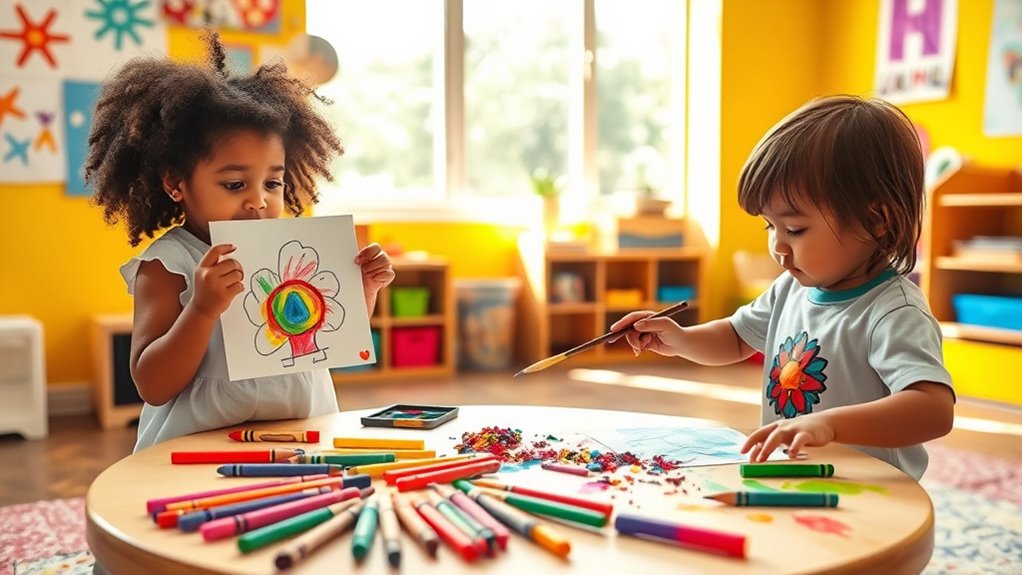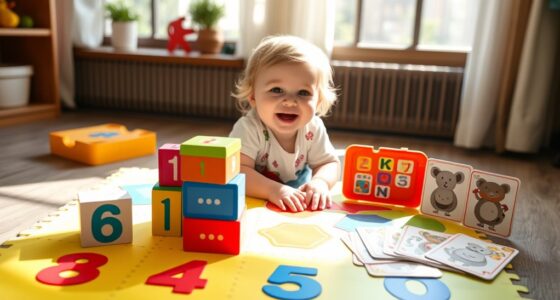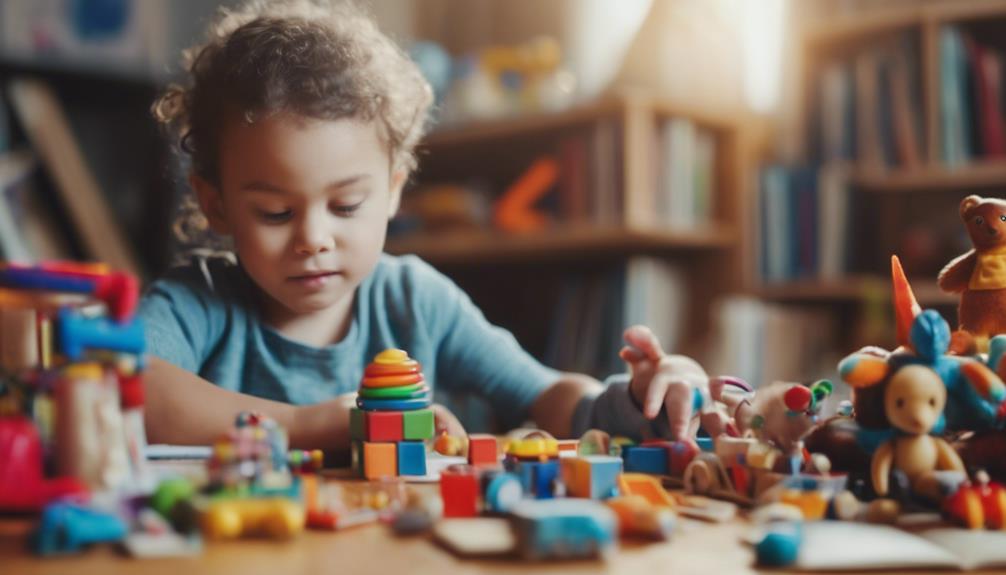Encouraging creativity in toddlers involves providing them with engaging art activities and playful exploration that tap into their natural curiosity. Set up a stimulating environment with easy access to textures, colors, and safe materials, and support their interests through simple projects and storytelling. Balance guidance with free exploration to help build confidence and self-expression. If you keep exploring, you’ll discover more ways to nurture your child’s artistic development and love of learning.
Key Takeaways
- Provide accessible, age-appropriate art supplies and a dedicated creative space to foster exploration.
- Incorporate simple, open-ended art activities like finger painting and collage to encourage self-expression.
- Follow the child’s lead, observing interests and supporting their unique creative choices.
- Use storytelling, pretend play, and puppets to stimulate imagination and cognitive development.
- Emphasize process over perfection, praising efforts to build confidence and emotional awareness.
The Benefits of Artistic Play for Young Children
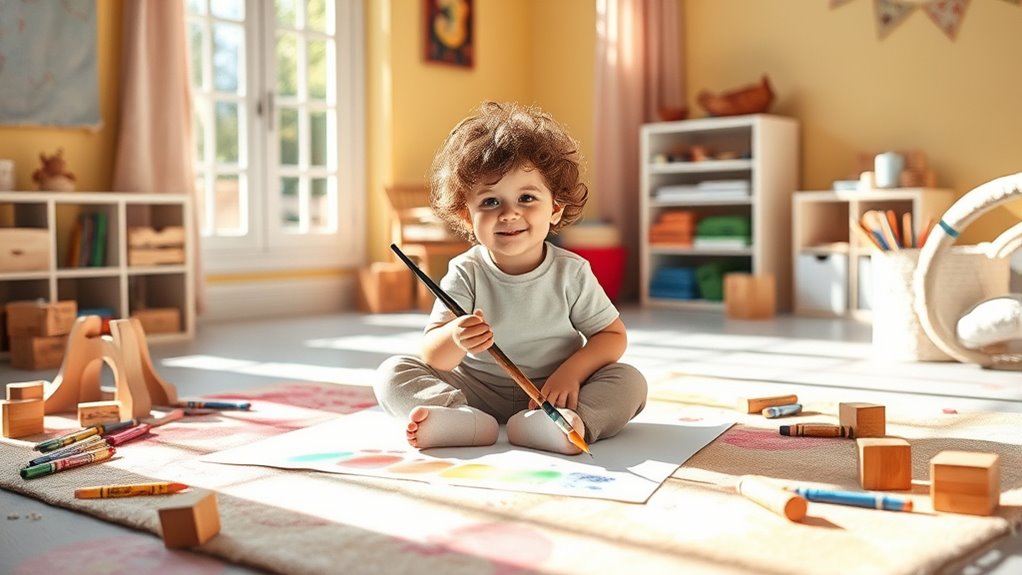
Engaging in artistic play offers numerous benefits for young children, helping them develop essential skills and fostering their natural curiosity. Art therapy is a powerful way for children to express emotions and process feelings through creative activities. It encourages sensory exploration, which enhances their ability to understand textures, colors, and shapes. When you provide opportunities for artistic play, you’re supporting their fine motor skills as they grasp brushes or crayons. This type of play also boosts cognitive development by encouraging problem-solving and decision-making. Moreover, engaging in art activities nurtures confidence and independence as children create freely. Additionally, incorporating educational content into art activities can further enhance their learning experience. As automation and innovative technologies become more prevalent, integrating digital tools with traditional art can enhance learning and stimulate creativity even further. Incorporating developmentally appropriate art materials ensures that children can explore safely and effectively, maximizing developmental benefits. Utilizing early childhood development principles can help caregivers tailor activities to suit different ages and abilities, ensuring optimal growth. Overall, artistic play is a crucial tool in early development, offering a fun, meaningful way to explore their world while building emotional and sensory skills.
Creating a Stimulating Environment for Creativity
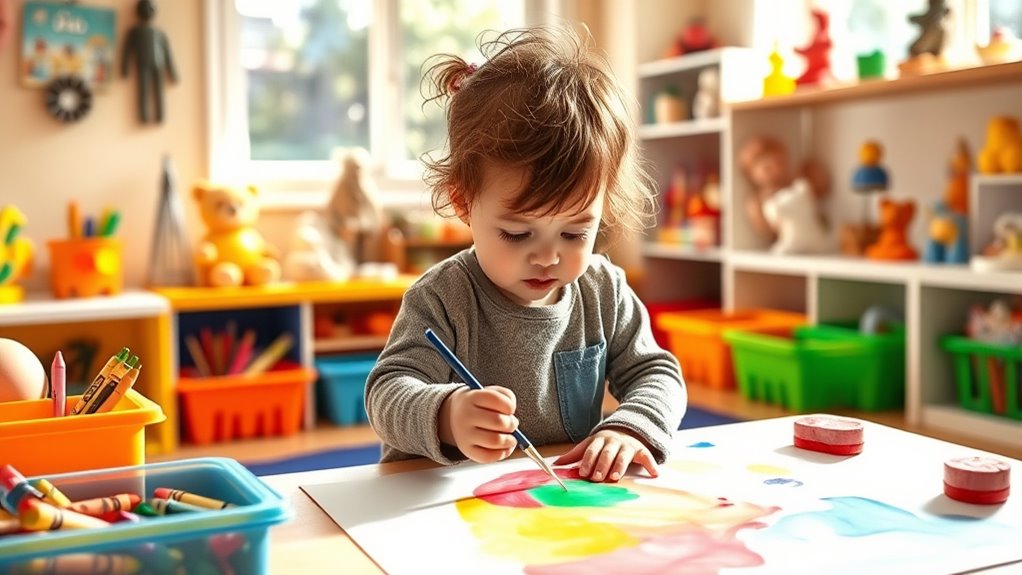
Creating a stimulating environment for creativity involves thoughtfully arranging your child’s space to inspire exploration and expression. Focus on sensory stimulation and an effective environmental layout that encourages curiosity. Here are some ideas:
Design a creative space with sensory-rich elements and open layout to inspire your child’s exploration and expression.
- Designate a dedicated art corner with accessible supplies like crayons, paper, and textured materials.
- Use varied textures and colors in the space to stimulate the senses and spark ideas.
- Arrange furniture to create open areas that invite movement and spontaneous play.
- Incorporate natural elements like plants or stones to enhance sensory experiences.
- Understanding sensory stimulation can help in creating a calming and engaging environment for your child. Additionally, incorporating elements that promote environmental layout can further support your child’s creative development. Recognizing the importance of emotional support in a child’s growth can also foster confidence and curiosity as they explore new creative avenues.
Simple Art Activities to Engage Your Toddler
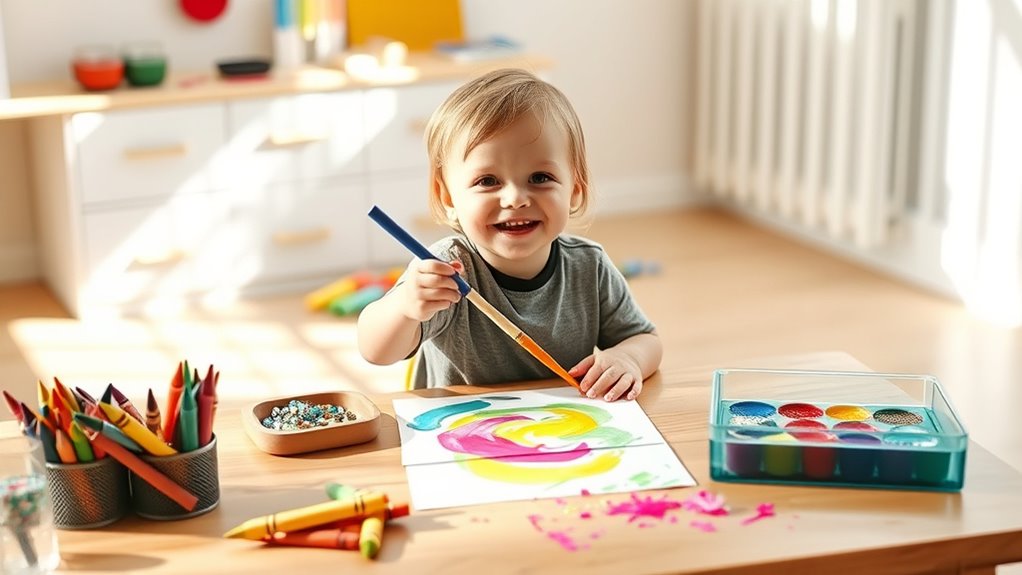
Simple art activities are a wonderful way to stimulate your toddler’s creativity and develop their fine motor skills. Finger painting allows your child to explore colors and textures directly with their fingers, fostering sensory development and encouraging self-expression. Set up a safe, washable space and watch them create spontaneous masterpieces. Collage making is another engaging activity; provide various materials like paper, fabric, and stickers for your toddler to glue onto a poster board. This activity boosts their hand-eye coordination and introduces basic concepts of composition and design. Keep the activities simple, and let your child lead the way. These hands-on art projects make learning fun and help nurture their natural curiosity and artistic confidence. Incorporating simple, engaging activities like these can also support early development of their cognitive and emotional skills. Engaging in these activities can also promote early childhood development, helping your toddler build essential skills for their growth. Additionally, introducing age-appropriate art tools can enhance their understanding of different art techniques, laying a foundation for future creative exploration. Furthermore, incorporating elements of Waldorf toys into art activities, such as natural materials and open-ended toys, can deepen sensory engagement and inspire imaginative play.
Incorporating Play-Based Learning Into Daily Routines
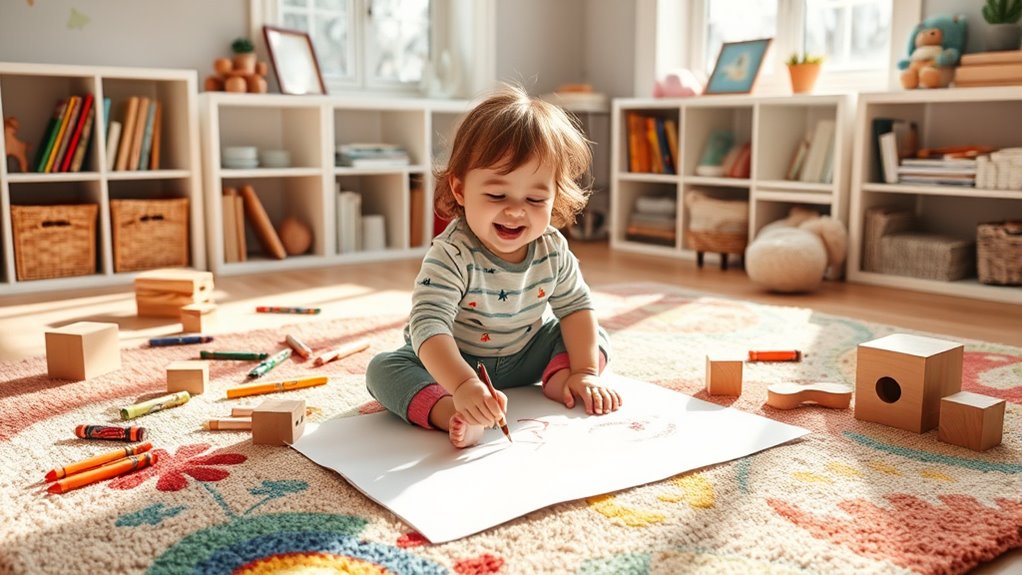
Incorporating play-based learning into your toddler’s daily routines makes learning natural and enjoyable. You can integrate activities that promote sensory integration and stimulate creativity. For example:
- Use music therapy during playtime to enhance emotional expression and auditory skills.
- Incorporate sensory bins filled with textured materials to encourage exploration and fine motor skills.
- Sing simple songs during daily chores to develop language and memory.
- Create movement games that involve jumping, dancing, or crawling, fostering gross motor development and sensory processing.
- Incorporate electric bikes or similar equipment into active play to encourage movement and coordination in outdoor settings. Additionally, introducing age-appropriate visual stimulation activities can further support cognitive growth and attention span development. Incorporating sensory integration activities can also help your toddler process and respond to sensory information more effectively. Implementing these developmental activities ensures your child’s growth is both engaging and effective.
These activities make learning seamless and fun, helping your toddler build essential skills while engaging their senses. By embedding play into daily routines, you create a rich environment for creative growth and development.
Encouraging Self-Expression Through Creative Projects
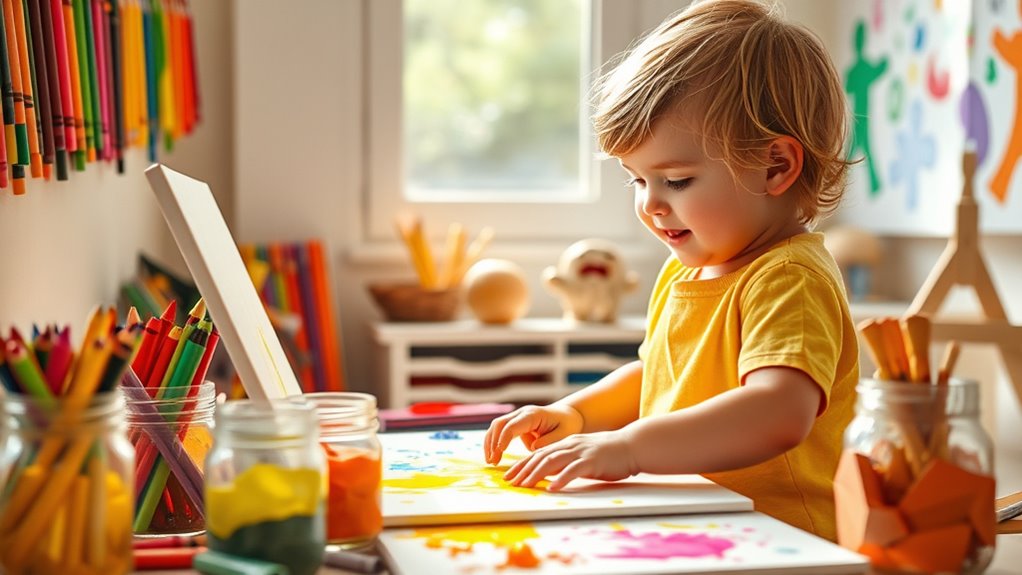
Encouraging your toddler to express themselves through creative projects helps build confidence and individuality. Focus on highlighting their personal style by allowing choices and exploring different ways to create. Providing a variety of materials makes it easier for them to experiment and discover what excites them most. Incorporating versatile applications such as drawing, painting, or sculpting can also introduce them to new techniques and inspire further creativity.
Emphasize Personal Style
When you allow toddlers to explore their personal style, you give them a powerful way to express themselves through creative projects. Emphasizing personal style helps nurture their personal expression and builds confidence in showcasing their unique identity. To support this, consider these ideas:
- Let them choose colors and materials that resonate with them.
- Encourage combining different textures or patterns for a one-of-a-kind look.
- Celebrate their creative decisions, even if they differ from your preferences.
- Display their work prominently to reinforce pride in their unique style.
- Incorporate sound design techniques, such as varied textures and effects, to inspire their auditory exploration and further enhance their creative expression. Recognizing the importance of artistic expression in early development can also foster their innate curiosity and desire to explore new mediums.
Provide Diverse Materials
Providing a variety of materials is essential for inspiring toddlers to explore their creativity and express themselves freely. When you offer different textures, like soft fabrics, rough paper, and smooth clay, it encourages sensory exploration and adds depth to their projects. Including a diverse color palette—bright reds, calming blues, vibrant yellows—stimulates their visual senses and sparks imagination. These materials invite toddlers to experiment, combine, and create without restrictions, fostering confidence in their self-expression. Keep materials accessible and age-appropriate, so they can choose what excites them most. By offering an array of textures and colors, you create an environment where toddlers feel free to innovate, develop fine motor skills, and discover their unique artistic voices through hands-on play.
Using Storytelling and Imagination to Enhance Creativity
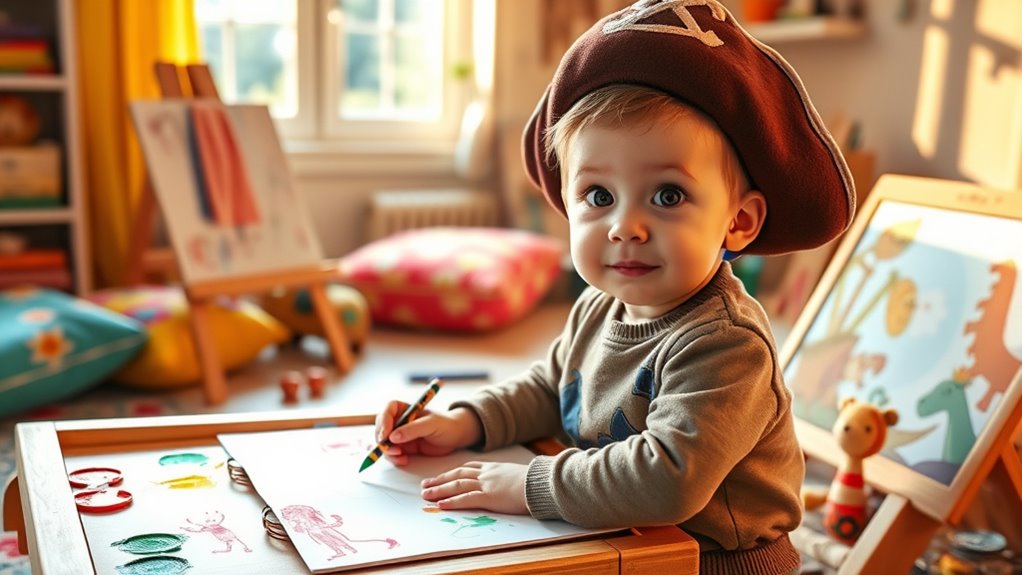
Storytelling and imagination are powerful tools for sparking your toddler’s creativity. Engaging in storytelling techniques encourages your child to think creatively and develop language skills. Imaginative play allows them to explore new worlds and ideas. To boost this, try:
- Creating simple stories together, asking your toddler to add details.
- Using puppets or toys to act out stories, making it interactive.
- Encouraging your child to invent their own stories from pictures or everyday objects.
- Playing pretend games, like “doctor” or “superhero,” to foster imaginative play.
These activities help your toddler develop cognitive flexibility and emotional understanding. Incorporate storytelling into daily routines, and watch their creativity flourish through active participation and open-ended play.
Supporting Your Toddler’s Artistic Development
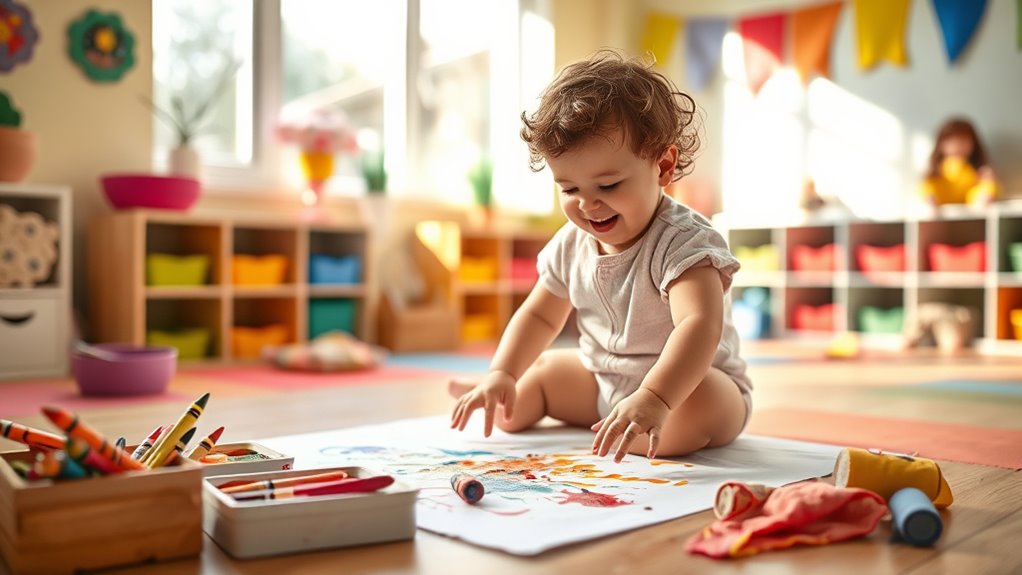
Encouraging your toddler’s creativity extends beyond storytelling and imaginative play to include their artistic development. You can support this by introducing art therapy techniques, which help your child express emotions and build confidence through art. Keep art materials accessible and safe, encouraging open-ended exploration. Use digital media thoughtfully to inspire creativity—interactive drawing apps or simple photo projects can enhance their skills without replacing hands-on activities. Observe and praise their efforts, focusing on the process rather than perfection. By creating a supportive environment, you help your toddler develop fine motor skills, emotional awareness, and confidence. Remember, fostering artistic growth is about offering opportunities, not directing every detail, allowing your child to explore and enjoy their unique creative journey.
Tips for Balancing Guidance and Free Exploration
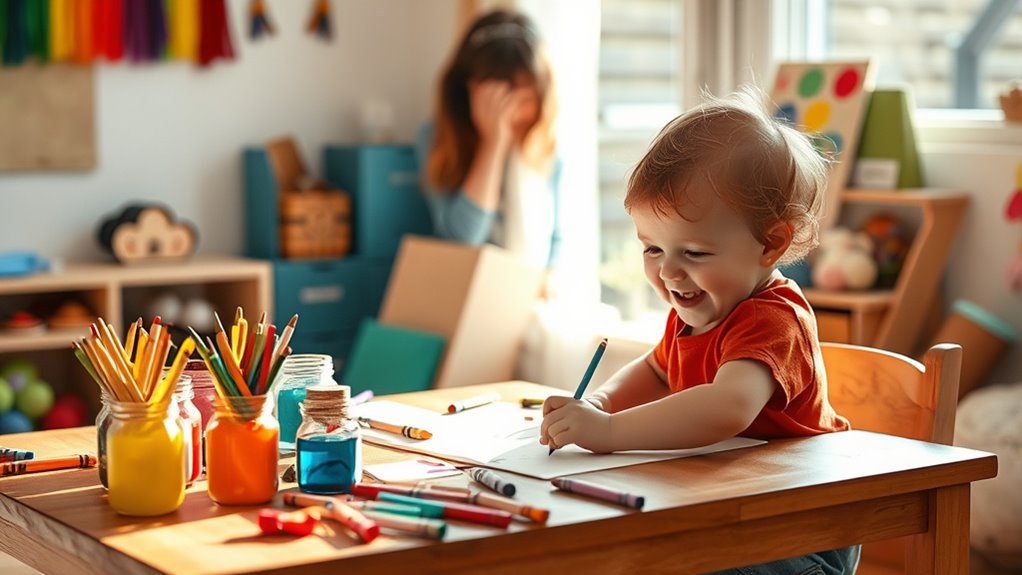
Finding the right balance between guiding your toddler and allowing for free exploration can be challenging, but it’s essential for fostering independence and creativity. To achieve this, focus on thoughtful parental involvement and setting boundaries that encourage safe, open-ended play.
Here are some tips:
- Offer open-ended materials that invite creativity without strict rules.
- Set clear boundaries to keep exploration safe without stifling curiosity.
- Observe your child’s interests and follow their lead during activities.
- Provide gentle guidance when needed, offering support rather than direction.
Frequently Asked Questions
How Can I Tell if My Toddler Is Genuinely Interested in Art?
You can tell if your toddler is genuinely interested in art by observing their enthusiasm for artistic expression and imaginative play. Notice if they keenly pick up crayons, paint, or paper, and if they enjoy experimenting with colors and shapes. When they create with focus and pride, it shows a real interest. Their willingness to explore different materials and incorporate their imagination into their work indicates a budding love for artistic play.
What Are Some Signs of Creative Development in Toddlers?
Imagine your toddler’s mind as a colorful garden bursting with vibrant flowers of imagination. Signs of creative development include their ability to weave imaginative storytelling from simple pictures and their enthusiastic for sensory exploration—touching, smelling, tasting, or listening to new things with curiosity. You’ll notice them experimenting confidently, blending ideas, and expressing emotions freely, showing they’re blossoming in their creative journey.
How Do I Handle Messes During Art and Play Activities?
When handling messes during art and play, it’s best to have clean-up strategies in place. You can set up a designated area for messy art activities, use washable supplies, and keep cleaning supplies nearby. Encourage your toddler to help with cleanup, making it a fun part of the process. This way, you manage messy art activities effectively while fostering independence and creativity, without stressing over every spill or splatter.
Are There Specific Art Supplies Suitable for Very Young Children?
Are there specific art supplies suitable for very young children? Absolutely! You should choose safe, non-toxic paints that are easy to clean and gentle on little hands. Opt for chunky art tools that are designed for small grips, encouraging grasping and control. These supplies promote safe exploration, foster creativity, and make art time enjoyable. By selecting age-appropriate, safe materials, you help your toddler develop confidence while having fun with their artistic pursuits.
How Can I Encourage Creativity in Children With Developmental Delays?
You can encourage creativity in children with developmental delays by focusing on sensory exploration and motor skills. Offer tactile activities like finger painting or playdough to stimulate their senses and enhance fine motor control. Use simple, accessible art supplies and create a supportive environment where they feel safe to experiment. As they explore and manipulate materials, you’ll help foster their creativity while supporting their developmental progress.
Conclusion
By fostering a creative environment and encouraging your toddler’s self-expression, you set the stage for lifelong learning and confidence. For example, imagine a child who, after regular art sessions, starts inventing stories from their drawings, showcasing their growing imagination. Remember, your support and patience make all the difference. Keep nurturing their curiosity through playful activities, and you’ll help them develop essential skills while having fun together. Your involvement truly sparks their artistic journey.

